Introduction |
Formats |
Printings |
Dies |
Paper |
Straight Edges |
Coils |
Fakes |
Forgeries |
Terminology |
Varieties |
Cancellations |
Rates |
Bibliography
Fake Coil and Imperforate Stamps
Stamp collectors always have to be on guard against stamps that have been tampered with to make them appear to be other (usually) more valuable stamps. There are several Admiral stamps that fall into this category. Consequently, stamp collectors ought to know how to tell the difference between genuine stamps and those that are not.
This page examines stamps that have had the perforations trimmed off to make fake coil or imperforate stamps. Another page examines two overprints found on the Admirals, both of which have been forged.
1. 2¢ Green Endwise Coil, Perf. 12 Horizontally
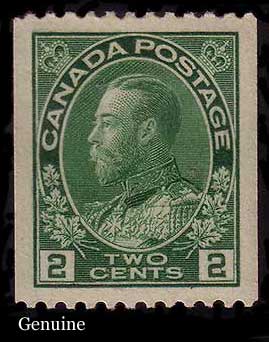
Only 250,000 perf 12 endwise coils were issued. Because of its obvious scarcity, this stamp has been faked more than any other Admiral stamp, although perhaps the imperforates are not too far behind. I have seen faked examples of this coil offered in dealers' stock books and auction catalogues. I have been looking at circuit books for more than 20 years, and when this stamp shows up in them, it is usually a fake. If this stamp is purchased through the various Internet auction sites, chances are pretty good that it will not be genuine.
Fortunately it is easy to tell a genuine stamp from one that has been faked. I will show characteristics of the genuine stamp and also examine several fake coil stamps to show how they can be identified as such.
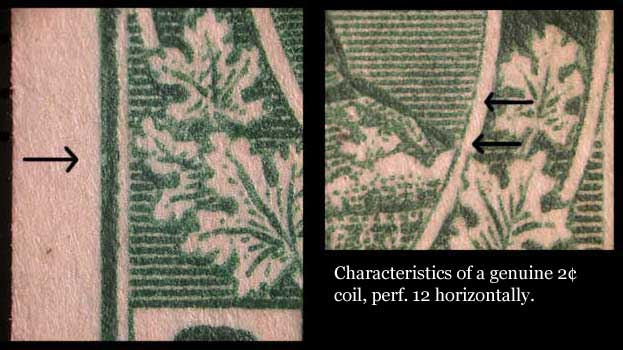
Genuine stamps have the following three characteristics:
- There is a weak spot (or "nick" - Marler's term) in the left frame line just to the left of the second leaf. See arrow in the left illustration above.
- The line around the oval portrait is broken at the King's shoulder and several lines above. These breaks are more visible on some stamps than on others, but are always present. See arrows in the right illustration above.
- The stamp is printed by the wet method, and is therefore narrow compared to stamps printed by the dry method.
Although the illustrations above are very clear, these characteristics appear even more pronounced when viewing a genuine copy of this coil stamp with just a little magnification.
2. Fake 2¢ Coil Stamps
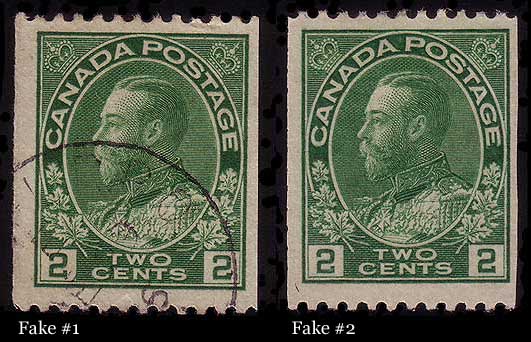
Illustrated above are two fake endwise coil stamps from a large group of 2¢ Admirals I got via the Internet. In addition to the fact that neither stamp has the characteristics of genuine coils described above, there are some other rather obvious signs that these are fake coils. Many other fake coils will probably have these same signs.
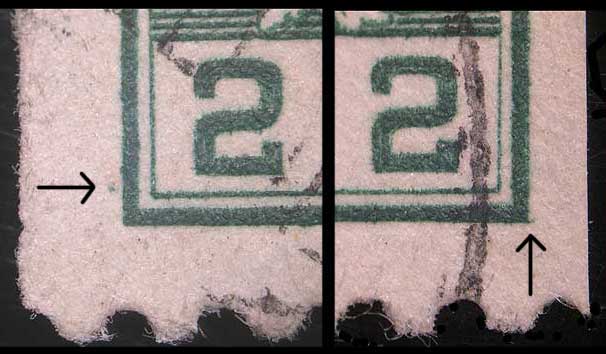
On the stamp labeled "Fake #1" above, the straight edge on the left side is characteristic of a straight edge coming from a post office pane of 100. Nine stamps from every pane of 100 have a straight edge either on the left side or the right side. Straight edges on these stamps are a bit rougher than those on booklet panes or coils. You will also notice the straight edge on the right side of "Fake #1" is very clean-cut. This "coil" obviously started out as a straight edge stamp from a pane of 100 that had a nice large margin on the left side.
Another sign this is a fake coil stamp is the green dot just to the left of the left numeral box and the small spur at the right end of the bottom frame line (see arrows in the illustrations above). These are characteristics of the re-engraved die and do not exist on genuine copies of this coil stamp.
Finally, this stamp was printed by the dry printing method and therefore it is a bit wider than a genuine coil stamp which was printed by the wet method. The person who made this fake coil wanted the margins to be as wide as possible because narrow coil stamps are suspicious right from the start. Dry-printed stamps often have wider margins than wet-printed stamps, so they are more likely to be used for faking this particular coil stamp.
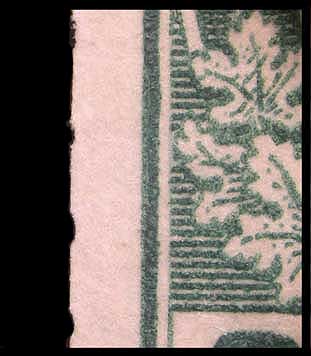
The stamp labeled "Fake #2" above is printed by the wet process, as are genuine coil stamps. However, this "coil" has other obvious signs that it is a fake. On first glance, this stamp appears to be too narrow. Closer examination shows the straight edge on the right side is not straight. The straight edge on the left side still has the bottoms of the perforation holes visible (see enlarged illustration above.) This "coil" stamp was obviously made by trimming the perforations off the sides of a regular completely perforated stamp.
It is amazing how such a crude fake can fool unwary stamp collectors. Often the fake coils and/or imperforates I see for sale have small portions of the perforation holes still showing!
3. Other Fake Coil Stamps
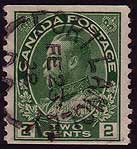
From time to time, "coil" stamps perf. 12 vertically - such as the stamp shown above - show up in old collections or at stamp dealers' tables. I remember finding a set of four such coils at a dealer's table several years ago. When I pointed out to him that they were all fake coils, he told me to just put them back where I found them if I did not want to purchase them.
No sidewise coil stamps were issued perforated 12 vertically. Coil stamps with vertical perforations are perf. 8, not perf. 12. Again, perforations were trimmed off one side of a stamp with a straight edge. Whoever made this "coil" stamp ruined a stamp with a lovely SON cancellation.
4. Fake Imperforate Stamps
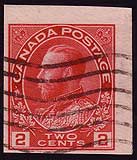
The stamp illustrated above is a single booklet pane stamp made to look like an imperforate stamp. Booklet pane stamps often have large margins on two adjacent sides. It is easy to trim the perforations off the other two sides to create an "imperforate" stamp. When you see an imperforate Admiral with two large adjacent margins and two close-cut adjacent margins, chances are pretty good that it is a fake. Ironically, the 2¢ carmine denomination was not issued imperforate, and had this stamp not been tampered with, it would have been quite a bit more valuable as a "squat" booklet pane single than it is now as a fake imperforate stamp.
The 1¢ yellow, 2¢ green, and 3¢ carmine Admirals were issued imperforate in quantities of 50,000 each. They were on sale only at the Philatelic Agency, and most of them were likely sold to stamp collectors who saved them as mint stamps. Used imperforate stamps exist, but not in large numbers. From the number of fake imperforate Admirals I see in stamp circuit books and on the Internet, trimming the perforations off stamps is a time-honored method of creating fake singles of these imperforate stamps.
Genuine single copies of these imperforate stamps can often be verified by using Marler's book, The Admiral Issue of Canada, to make sure the "types" are correct.
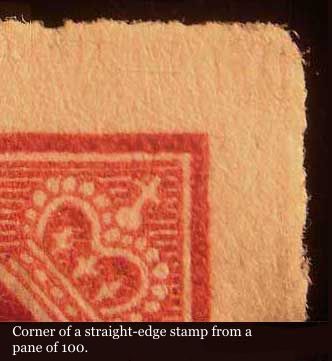
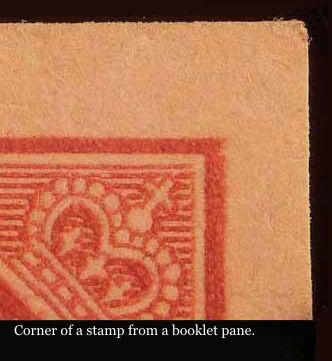
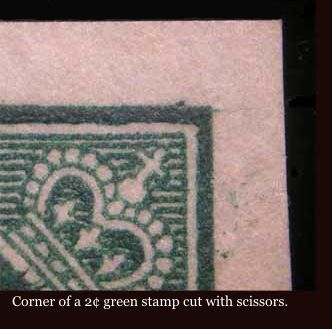
Knowing the characteristics of each type of straight edge will also help the Admiral collector avoid fake imperforate stamps. Illustrated above are magnified views of the upper right corners of three stamps:
- Top left: corner of a 2¢ carmine straight-edge stamp from a pane of 100. (Keep in mind that a pane of imperforate stamps will have two sides with edges that look like this one.)
- Top right: corner of a 2¢ carmine straight-edge stamp from a booklet pane.
- Bottom: corner of a 2¢ green stamp that was cut with scissors.
Used imperforate singles should probably be avoided because they are just too easy to fake. Buying imperforate Admirals only in pairs, blocks, or larger multiples is the best way of getting genuine copies of these stamps.
Introduction |
Formats |
Printings |
Dies |
Paper |
Straight Edges |
Coils |
Fakes |
Forgeries |
Terminology |
Varieties |
Cancellations |
Rates |
Bibliography